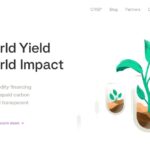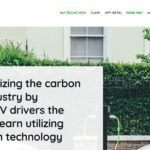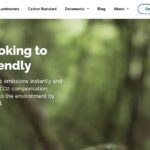Flowcarbon Goddess Nature Token in Focus
Established in 2021, Flowcarbon has recently secured a whopping $70 million in funding to expand its platform and team. Out of this, a16z crypto contributed $32 million, alongside notable investments from General Catalyst, Samsung Next, Invesco Private Capital, among others. The residual amount was garnered through the sale of their unique token – Flowcarbon Goddess Nature Token.
Flowcarbon liaises with two primary sectors:
- Businesses: Flowcarbon aids companies in mapping out and realizing their climate objectives. This involves evaluating their carbon footprint, formulating a carbon offset strategy, offering access to a global inventory of carbon projects, and fortifying their marketing and communication endeavors.
- Project Developers: Flowcarbon assists project developers in evaluating the viability of their projects and shaping a blueprint aligned with their aspirations. Moreover, Flowcarbon presents diverse financing solutions for budding projects and delves into various avenues to monetize developers’ carbon offsets.
Now, let’s delve deeper into Flowcarbon’s pioneering approach to tokenize carbon offsets.
Flowcarbon Goddess Nature Token Process
The number of carbon offsets tokenized using this two-way bridge algorithm remains unclear. It’s important to note that, concurrently with Flowcarbon’s tokenization efforts, major carbon registries banned such procedures. Presently, Flowcarbon actively participates in public consultations by Verra and Gold Standard to help establish rules for tokenization. It’s highly likely that once these rules are published, the tokenization mechanism will resume.
Minting GCO2 tokens
The GCO2 token is an ERC-20-compatible token that represents a verified removal or reduction of one tonne of carbon dioxide equivalent. To mint GCO2 tokens, you need to have an account at Carbon offset registry and a Celo account controlled by a compatible wallet.
Flowcarbon handles the entire GCO2 token creation process. Once you submit a tokenization request, Flowcarbon verifies the information with the registry and transfers the credits to a bankruptcy remote special purpose vehicle (SPV). A new smart contract is then created, which contains information about the batch of carbon credits, such as the name, symbol, methodology, credit type, and vintage. A unique token is created for each project and vintage of a project. The GCO2 tokens are then transferred to the account of the original credit owner.

Retiring GCO2 tokens
GCO2 tokens can be retired on-chain without the need to interact with the registry of the underlying carbon credit.
To retire tokens, the token holder initiates a retirement request to Flowcarbon, specifying the quantity of tokens he would like to retire. This decreases the token holder’s balance and increases their retirement balance. The retired tokens accumulate in the contract until they reach a certain threshold. Once the threshold is met, the bankruptcy remote SPV retires the corresponding carbon credits in the underlying registry. A UUID (universally unique identifier) is generated to record the retirement event, and a tamper-proof checksum is created as proof of existence for auditing purposes. The retired tokens are then burned.

Redeeming GCO2 tokens
GCO2 tokens can be redeemed for the underlying carbon credits at any time. The redemption process is initiated by the token holder, who submits a request to Flowcarbon. Flowcarbon verifies the request and confirms that the token holder has an account at the appropriate registering body. Once the request is approved, the GCO2 tokens are burned by the GCO2 smart contract and the physical carbon credits are transferred from the bankruptcy remote SPV to the token holder’s account.
There is a standard 2% fee for redemption. This means that if a GCO2 holder requests to redeem 100 GCO2s, they will receive back 98 off-chain carbon credits.

Bundle tokens
Bundle tokens are a type of token that can be created by depositing GCO2 tokens into a bundle. Bundle tokens are issued on a one-to-one basis with GCO2 tokens, meaning that if you deposit 50 GCO2 tokens into a bundle, you will receive 50 bundle tokens in return.
To create a bundle, you first need to deposit GCO2 tokens into the bundle contract. You can do this using Flowcarbon’s dApp. Once the GCO2 tokens are deposited, the bundle contract will mint an equivalent number of bundle tokens, which will be sent to your wallet.
Bundle tokens can be withdrawn from the bundle at any time. When you withdraw bundle tokens, the GCO2 tokens that were used to create them will be transferred back to your wallet.
Bundle tokens can also be retired or redeemed. When you retire or redeem bundle tokens, the GCO2 tokens that were used to create them will be retired or redeemed from the underlying registry.

Flowcarbon Goddess Nature Token (GNT)
GNT is the first bundle token that was issued by Flowcarbon.
The acceptance criteria for the GNT bundle are:
- The project must use a nature-based methodology.
- The project must have a five-year vintage period, inclusive of the current year.
- The project must be backed by credits from market-recognized standards.
Currently, there’s no updated information regarding the movement of this token. As of now, Flowcarbon Goddess Nature Token tokens cannot be acquired. From available open-source information, it is known that:
- GNT tokens valued at $38 million were distributed to investors.
- An agreement existed with the Celo Foundation and Climate Collective to purchase at least $10M worth of GNT.
- There was a plan in place for an agreement with C+Charge to provide on-chain carbon credits for network users.










